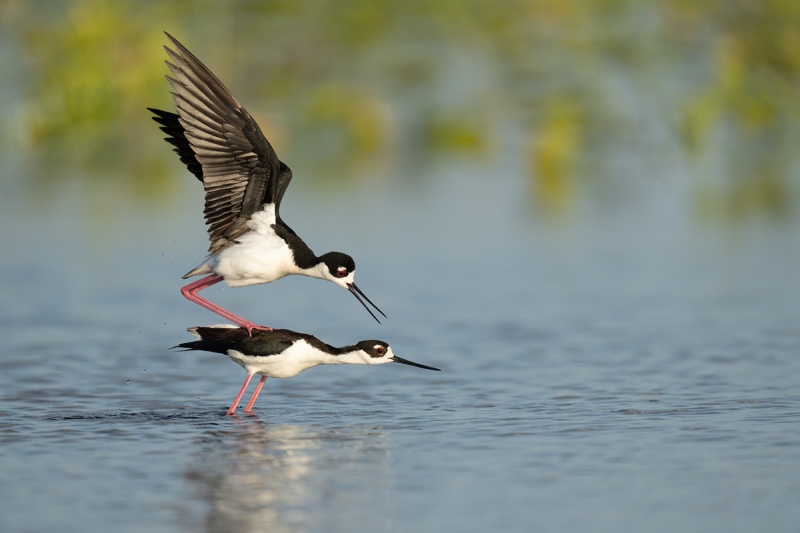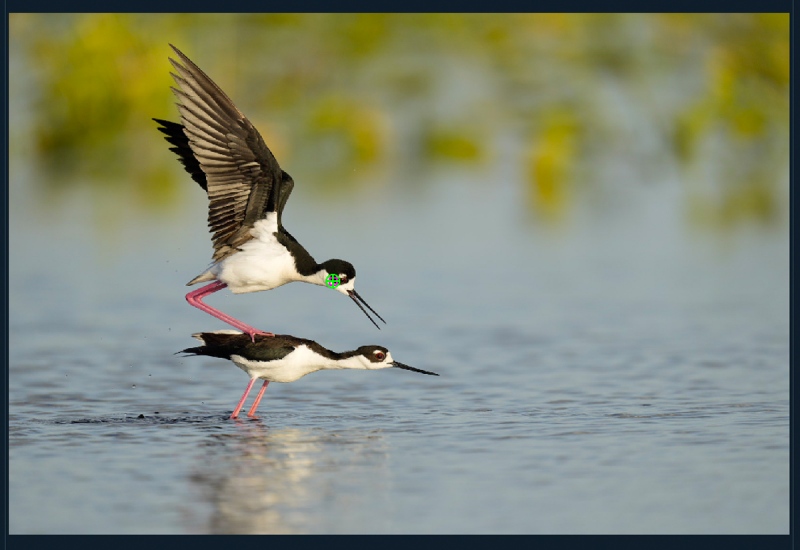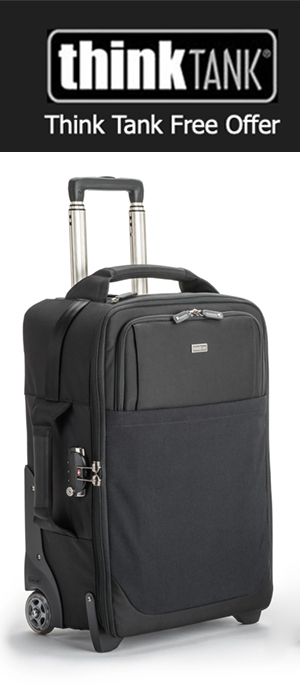What’s Up?
On Sunday morning we sat in the marsh again and enjoyed another great day with the Black-necked Stilts. Again, they landed right in front of us and copulated. Twice. In addition, we got some great stuff on Boat-tailed Grackles grabbing snails. Toward the end of the session, I did some ultra-low-level shooting off the tripod with the Levered-clamp FlexShooter Pro. That gets me down to about a foot above the mud. I am getting better and better at working off the rear monitor. Techniques for doing that will be shared here soon.
Thanks to all who left comments on Anita’s images yesterday. As I wrote in reply to one comment, Anita’s images are not perfect. Had anyone pointed out some of the legitimate flaws, I would have thanked them very much. The point of the post, however, was that she worked very hard to discover a new location and got some very good images. Not to mention that the first three images were made in extreme low light conditions. I have been preaching here for years that depth of field with super-telephoto lenses, especially with subjects at relatively close range, is very shallow. And some folks on BPN often ask for “more d-o-f” in low light-, already high ISO-, slow shutter speed situations. That is why for decades, my mantra has been to focus on the eye, get that sharp, and to heck with depth of field.
There are many other comments and replies worth reading. Learn more about d-o-f with long lenses in today’s post below.
Today is Monday 17 May 2021. The forecast is for still and sunny with a light breeze from the northeast developing. We are heading down to the lake early. Wherever you are, and whatever you are doing, I hope that you have a great day.
This blog post took about two hours to prepare and makes 144 consecutive days with a new one. Please remember that if an item — a Delkin flash card, or a tripod head — for example, that is available from B&H and/or Bedfords and is also available in the BAA Online Store, it would be great if you opt to purchase from us. We will match any price. Please remember also to use my B&H affiliate links or to save 3% at Bedfords by using the BIRDSASART discount code at checkout. Doing either often earns you free guides and/or discounts. And doing so always earns my great appreciation.
Please Remember
With income from IPTs now at zero, please, if you enjoy and learn from the blog, remember to use one of my two affiliate programs when purchasing new gear. Doing so just might make it possible for me to avoid having to try to get a job as a Walmart greeter and will not cost you a single penny more. And if you use Bedfords and remember to enter the BIRDSASART code at checkout, you will save 3% on every order and enjoy free second-day air shipping. In these crazy times — I am out at least forty to sixty thousand dollars so far due to COVID 19 (with lots more to come) — remembering to use my B&H link or to shop at Bedfords will help me out a ton and be greatly appreciated. Overseas folks who cannot order from the US because of import fees, duties, and taxes, are invited to help out by clicking here to leave a blog thank you gift if they see fit.
New and Better Bedfords Discount Policy!
You can now save 3% on all of your Bedfords photo gear purchases by entering the BIRDSASART coupon code at checkout. Your discount will be applied to your pre-tax total. In addition, by using the code you will get 2nd day air shipping via Fed Ex.
Grab a Nikon AF-S Teleconverter TC-14E III and save $14.99. Purchase a Canon EOS R5 and your discount will be $116.97. Purchase a Sony FE 600mm f/4 GM OSS lens and save a remarkable $389.94! Your Bedford’s purchase no longer needs to be greater than $1,000.00 for you to receive a discount. The more you spend, the more you save.
Money Saving Reminder
Many have learned that if you need a hot photo item that is out of stock at B&H and would enjoy free second-day air shipping, your best bet is to click here, place an order with Bedfords, and enter the coupon code BIRDSASART at checkout. If an item is out of stock, contact Steve Elkins via e-mail or on his cell phone at (479) 381-2592 (Central time). Be sure to mention the BIRDSASART coupon code and use it for your online order to save 3% and enjoy free 2nd-day air shipping. Steve has been great at getting folks the hot items that are out of stock at B&H and everywhere else. The wait lists at the big stores can be a year or longer for the hard to get items. Steve will surely get you your gear long before that. For the past year, he has been helping BAA Blog folks get their hands on items like the SONY a9 ii, the SONY 200-600 G OSS lens, the Canon EOS R5, the Canon RF 100-500mm lens, and the Nikon 500mm PF. Steve is personable, helpful, and eager to please.


Gear Questions and Advice
Too many folks attending BAA IPTs (remember those?) and dozens of photographers whom I see in the field and on BPN, are–out of ignorance–using the wrong gear especially when it comes to tripods and more especially, tripod heads… Please know that I am always glad to answer your gear questions via e-mail
|
|
|
This image was created on 15 May 2021, my first morning of sitting on a milk crate in the marsh along the lakeshore at ILE. I used the Induro GIT 304L/Levered-clamp FlexShooter Pro-mounted-Sony FE 600mm f/4 GM OSS lens and The One, the Sony Alpha 1 Mirrorless digital camera. ISO 500. Exposure determined via Zebras with ISO on the rear dial: 1/4000 sec. at f/4 (wide open) in Manual mode. AWB at 7:39am on a clear sunny morning. Wide/AF-C was active at the moment of exposure and performed perfectly by nailing the plover’s eye. Click on the image to see a larger version. Image #1: Black-necked Stilts, pre-copulatory stand |
Thanks! Anita
Thanks to Anita for coming up with the idea of sitting on a milk crate in the marsh. It is something that I will be doing quite often — not only in May, but throughout the year. Right now, however, the opportunities have been amazing. We can hardly wait to get up each day and head down to the lake. I’ve gone down the last two mornings, and we’ve had two copulations right in front of us each day. Plus numerous fights between pairs from abutting territories.
The courtship rituals of all members of the Recurvirostridae family, the stilts and avocets, are entirely fascinating and beautiful. You will be seeing images here over the next few weeks of the various courtship behaviors. I have seen this species in previous years as the water level in the lake drops, but had only photographed them from afar (and not very well) working at 1200mm. As long as we sit and stay still, they come right up to us. Today is day four for Anita, and day three for me. We have been improving our strategies and techniques each day and will continue to do so.
And who knows, perhaps they will nest successfully this year at ILE for the first time … I have never seen a BNST chick here …
Depth of Field with Super-telephoto Lenses
I have attempted to share the information below here on the blog for many years. But after reading some of the comments on yesterday’s blog post, my teachings — for some folks — have fallen on deaf ears. Here are the facts:
Depth-of-field (d-o-f) with super-telephoto lenses is extremely shallow when working at or near the wide open aperture. The closer you are to the subject, the less the d-o-f. Working a 600mm lens at 15 feet at f/4, the total d-o-f is less than 1/4 inch. Increase the distance to 50 feet, and the d-o-f increases to roughly 3 3/4 inches. In each situation, stopping down two full stops roughly doubles to the total d-o-f. Note that with super-telephoto lenses, the d-o-f is about 50/50 with half of the d-o-f in front of the point of focus, and half behind.
Today’s featured image was created at a distance of about 50 feet, perhaps 60. Though the d-o-f was 5.4 inches at most, that was more than enough to cover both subjects. How do we know that? Because both birds are razor sharp.
I recommend stopping down with long lenses when you are very close to the subject. But realize then that the additional d-o-f you will gain will be minimal. Again, the d-o-f roughly doubles for each two stops that you stop down. But folks need to understand that there is a price to pay when stopping down. Stopping down two stops will cost you either two stops of shutter speed or two stops of ISO (or some combination of the two).
My strategy for three and and half decades has been to focus on the bird’s eye and let the d-o-f fall where it may. Unless you can verbalize a good reason for stopping down.
|
|
Image #1A: AF Points for the Black-necked Stilts, pre-copulatory stand image |
You-Gotta-Be-Kidding-Me AF Performance
Can your camera body detect and track the eye of a Black-necked Stilt, a dark red eye buried in a black cap? The Sony Alpha a1 can. Easily. As for the Sony Alpha a1 AF system, what can I say? The results that you see above are typical of those achieved with Animal Eye Tracking. You will not, however, get consistent results easily unless your AF Menu is set up correctly. If you own an a1, and are not getting the AF performance that you want and expect, consider joining the SONY a1 Info and Updates group. If you are planning on purchasing an a1 — the world’s best camera for bird photography, be sure to use one of my two affiliate links and earn free entry into the group. Details immediately below.
Sony Alpha a1 AF
Barring operator error, the performance of the Sony Alpha a1 AF system at any focal length — as we saw recently even at 1200mm — when your a1 is set up properly as detailed in the in e-mails to the Sony Alpha a1 Info & Updates group, more than remarkable. Early on, there was lots of discussion within the group with many preferring multiple back button approaches. For me a simple shutter button approach with the right AF settings that yield 99% sharp-on-the-eye images is best. By far. It is super-simple and mega-effective. In the next SONY Alpha a1 Set-up and Info Group e-mail, I will be sharing what I have learned as to when and it what situations it is best to abandon Wide. We have already learned to limit the AF Area choices and to switch AF Areas quickly and conveniently. The default method of switching AF points with the C2 button is both slow and cumbersome.
SONY Alpha a1 Set-up and Info Group
The SONY Alpha a1 Set-up and Info Group is going great guns as folks chime in with thoughtful questions and experience-based advice. We are now up to an astounding 41 folks. Early on, we discussed the myriad AF options. I gave my opinion as to the best one for flight and general bird photography. More recently, we have been in contact with folks at SONY sharing our thoughts, experiences, and frustrations with the EVF blackout problem.
All who purchased their Alpha a1 bodies via a BAA affiliate link will receive a free subscription to the Sony Alpha a1 Set-Up and Info Updates after shooting me their receipts via e-mail. (Note: it may take me several days to confirm B&H orders.) This same service may be purchased by anyone with an a1 body via a $150.00 PayPal sent to birdsasart@verizon.net indicating payment for Alpha a1 Info Updates. Alternatively, folks can call Jim weekdays at 1-863-692-0906 to pay via credit card. New members will receive composite e-mails that summarize all previous discussions.
Typos
With all blog posts, feel free to e-mail or to leave a comment regarding any typos or errors.

















Artie – I have a bad knee. Getting down is ok but getting up – well not so good. I use a camp stool with folding legs. It goes in a backpack, in carry on, etc. Not great in sand last March when photographing burrowing owls in Cape Coral, FL but OK. It is smaller than a milk crate but not as steady.
Thanks, Dietmar. That was a cut and paste error. Fixed, thanks to you.
with love, artie
Hi Artie,
under image 1 you indicate that you used the levered-clamp FlexShooter Pro and the Mongoose M3.6. I thought that one would not need the Mongoose if one uses the FlexShooter Pro. Can you please clarify. Thanks,
Dietmar
Hi Artie,
Has the use of Topaz Denoise encouraged you to use higher ISOs to obtain greater depth of field?
Typo at the end of the second paragraph…. and to “neck” with depth of field.
Thanks, and fixed.
with love, a
Hi Artie, appreciate your comments on DOF and frequently in lower light situations one has to make some compromises. The milk crate suggestion is a good one though I suspect that some of the younger photographers might be scratching their heads over what is a “milk crate”? In fact, I haven’t seen one in years though some of the inexpensive, collapsible step stools might serve a similar purpose? As an aside, do you have favorite pair/brand of wading boots for the marshes?
Hi Adam, Mine are from the Milk Barn from when I lived in Starrett City in Brooklyn. From about five decades ago. They are available on Amazon nothing near as sturdy as far as I know … Anita actually sits on a small plastic step stool. Or in the water.
If you click on the Stuff tab on the yellow/orange tool bar on each blog post page and scroll down you will find a link to my favorite surf booties. Right above those is what looks like a pretty sturdy milk crate.
with love, a